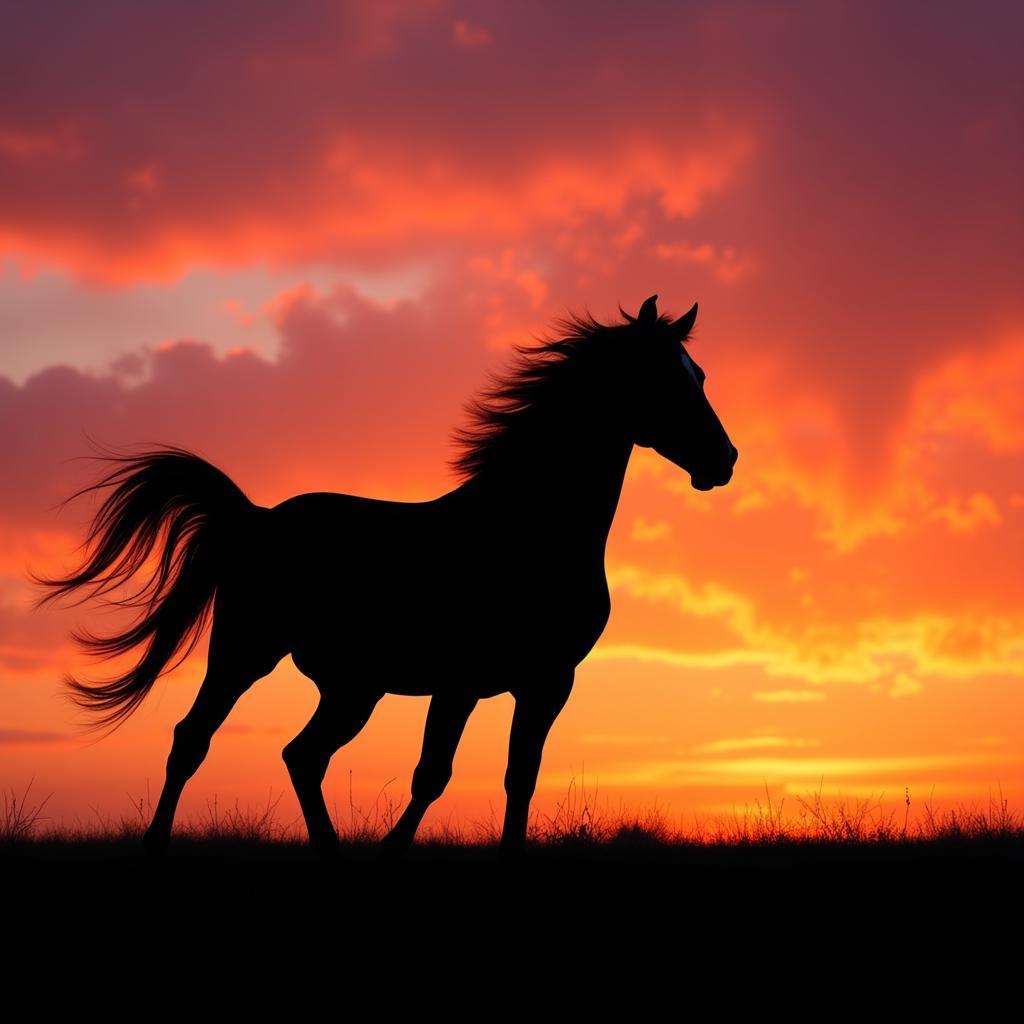Dark Horse Photography offers a unique challenge for both amateur and professional photographers. It’s about capturing the powerful presence and often overlooked beauty of these majestic creatures, shrouded in shadows and mystery. But how do you illuminate their inherent grace and strength in low-light conditions? This comprehensive guide delves into the art of dark horse photography, equipping you with the knowledge and techniques to transform your equine images into stunning works of art.
Unveiling the Beauty: Understanding the Challenges
Photographing dark horses presents a unique set of hurdles that require a keen understanding of light, shadow, and the nuances of equine anatomy. The lack of contrast between their dark coats and the surrounding environment can make it difficult to define their form and capture details.
 Dark horse silhouetted against a vibrant sunset
Dark horse silhouetted against a vibrant sunset
Mastering the Light: Tips for Optimal Illumination
- Embrace Natural Light: Soft, diffused natural light is your greatest asset. Overcast days or the hours surrounding sunrise and sunset provide ideal lighting conditions. Harsh midday sun can create unwanted shadows and distort the horse’s features.
- Utilize Artificial Lighting: When natural light is limited, artificial lighting can be strategically used to create dimension and highlight specific areas. Reflectors, external flashes, and diffusers can be employed to control and manipulate the light source.
- Experiment with Angles: Don’t be afraid to move around and experiment with different angles. Side lighting can help to define the horse’s musculature, while backlighting can create a dramatic halo effect.
Composition and Background: Framing Your Subject
- Choose a Clean Background: A cluttered or distracting background can detract from the beauty of your subject. Opt for a simple and uncluttered backdrop that contrasts with the horse’s dark coat.
- Rule of Thirds: Employ the rule of thirds to create a visually appealing composition. Imagine your frame divided into nine equal parts and position the horse off-center at one of the intersecting points.
- Negative Space: Don’t be afraid to embrace negative space. Leaving areas of emptiness around the horse can create a sense of drama and highlight its presence.
 Studio portrait of a dark horse with soft lighting
Studio portrait of a dark horse with soft lighting
Technical Considerations: Camera Settings and Equipment
- Aperture Priority Mode: Opt for aperture priority mode (Av or A) to control the depth of field. A wider aperture (lower f-number) will create a shallow depth of field, blurring the background and drawing attention to the horse.
- Shutter Speed: Ensure your shutter speed is fast enough to prevent motion blur, especially if the horse is moving. A shutter speed of 1/250th of a second or faster is recommended.
- ISO Sensitivity: Keep your ISO as low as possible to minimize noise. In low-light conditions, you may need to increase the ISO, but be mindful of the potential for grain.
- Lenses: A telephoto lens (70-200mm or longer) is ideal for capturing close-up portraits without disturbing the horse. A wide-angle lens can be used for environmental shots that showcase the horse in its surroundings.
Showcasing Personality: Capturing Expression and Emotion
- Focus on the Eyes: The eyes are the window to the soul, and this holds true for horses as well. Ensure the eyes are sharp and in focus to convey emotion and connection.
- Patience is Key: Horses are expressive creatures, but capturing those fleeting moments requires patience. Observe their behavior, wait for those subtle gestures, and be ready to click the shutter.
- Tell a Story: Strive to create images that tell a story or evoke an emotion. Capture the horse interacting with its environment, its handler, or other horses to create a sense of narrative.
Conclusion: Embracing the Challenge of Dark Horse Photography
Photographing dark horses is a rewarding pursuit that requires technical skill, artistic vision, and a deep appreciation for these majestic creatures. By understanding the challenges, mastering the light, and focusing on composition and emotion, you can create stunning images that celebrate the beauty and mystique of the dark horse. Remember, patience and practice are key. Embrace the journey and let your creativity run wild.
Need help capturing the perfect shot of your equine companion? Contact us at Phone Number: 0772127271, Email: [email protected] Or visit us at QGM2+WX2, Vị Trung, Vị Thuỷ, Hậu Giang, Việt Nam. Our team is available 24/7 to assist you.